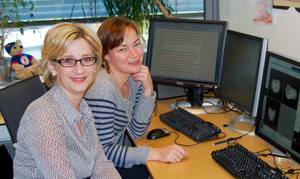– At present, we do not have sufficient evidence that high doses are safe for the unborn child.
She calls attention to current studies that indicate a connection between the size of methadone doses and negative clinical outcomes for the child. In a new trial mothers take a wide range of doses, but on average much lower than in Norway.
The mean dose in New Zealand was 59,7 mg per day, which is less than half the highest dose a family doctor in Norway can prescribe to a heroine addicted pregnant mother without consulting the health authorities.
Nevertheless, Woodward finds evidence of adverse clinical consequences for the children.
Dosage levels do matter
– A higher dose increases the risk for babies of being born preterm, of being symmetrically smaller and spending longer periods in hospital for treatment of Neonatal Abstinence Syndrome. These findings suggest a need to be moderate with the dose levels, says Woodward.
She visited the Department of Psychology at the end of September, both to present her research at a seminar but also to establish closer research cooperation with Professor Kristine Walhovd.
In 2010 Woodward published an article on the effects of maternal methadone dosages during pregnancy on a range of infant clinical outcomes.
Findings revealed that increasing maternal methadone doses corresponded with:
-
increase in infants' risk of being born preterm
-
infants being symmetrically smaller
-
infants spending longer periods in hospital being treated for Neonatal Abstinence Syndrome
The brain development of infants

Woodward and Walhovd are collaborating on a substudy of DTI imaging of early brain development in infants born to methadone-maintained mothers.
Brain development has previously not been assessed in this high-risk population of children.
– In the larger study we’re doing now we have 100 children born to mothers who are maintained on methadone and 110 children in the comparison group. We combine methods and use different types of MRI-scans, neurological exams and child development assessment tests.
– We continue the observations at 18 months, and again at 4 ½ years when we focus on the child’s readiness for school, Woodward explains.
A stabilized life
Psychologist and research fellow Monica Sarfi at the Norwegian Centre for Addiction Research (Seraf), UiO, was a member of the project group working out guidelines to a methadone maintenance treatment program called LAR (medically assisted treatment), for the Norwegian Health Directorate. She is also conducting research on a Norwegian group of children born to mothers in LAR.
– The LAR programme is aimed at women that are addicted to opioids. LAR helps them to live a normal life with family, job and social relations. A mother’s health is crucial for the development of her child.
– A high dosage treatment prevents relapse to heroine use, supplementary drugs and potential overdoses. A stabilized life supports the mother in keeping custody of her child and the unnecessary placing in foster homes is avoided. In the long term this benefits the child, contends Sarfi.
She acknowledges that it’s not optimal for the fetus, while at the same time emphasizing that the consequences of detoxification are risky too.
– Firstly, we don’t know what is happening with the fetus during detoxification. Secondly, very few women have managed to quit the LAR-medication during pregnancy. This is puzzling, says Sarfi.
She adds that many women become worried and stressed if given the impression that detoxification is the only way to prove that they are good mothers.
– We have experienced mothers dropping out of LAR and going back on heroin if they step down the dosage too much. Of course, women who want detoxification should be given the opportunity in a monitored environment.
– It’s important to support a good relationship between mother and child even before birth.
– Then the chances for her keeping the child increase, but this is only possible if her addiction is under control, Sarfi concludes.
References:
Wouldes & Woodward: Maternal methadone dose during pregnancy and infant clinical outcome, Neurotoxicology and Teratology, Volume 32, Issue 3, May-June 2010, Pages 406-413, doi:10.1016/j.ntt.2010.01.007.
